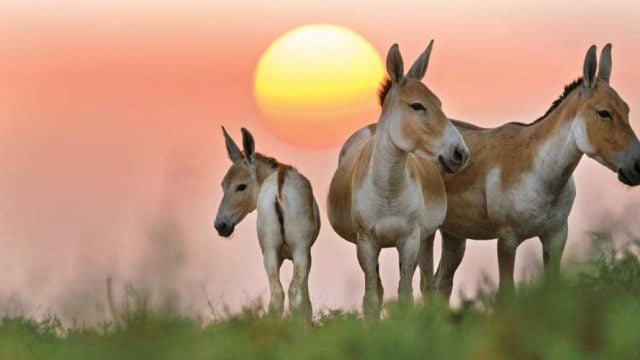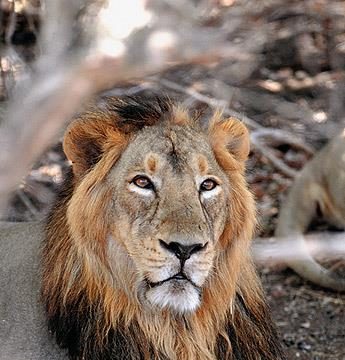The four-hour drive from Rajkot to Sasan Gir is predictably dominated by talk of lions and the

I am greeted by the front-office manager Lovesh Villayat with a refreshing drink of aam panna. The reception itself is open and informal with the main artwork here based on three materials—wood, stone and cotton. Stylish beadwork panels line the entrance wall, inspired by the torans of Saurashtra, the region we are in. “Every piece of furniture in the property has been designed in-house and made on the property itself, mostly using reclaimed wood,” says Lovesh. The wood is sourced from Alang in Gujarat, one of the largest ship-breaking yards in the world.

The minimalist design of the property, imbued with Gujarati art and craft traditions and moulded to a modern finish, lines every nook and cranny of the property. Handcrafted and curated by an in-house team of artists, architects and designers, just about every fitting and fixture at this resort is bespoke.

After a brief tour of the property, Lovesh turns the buggy towards my living quarters: a boutique pavilion, one of 12 standalone units that line the property besides a smattering of studios and a villa. The pavilion is based on the high plinth concept and is open on three sides. The wooden porch in the front, replete with a jhula (another Gujju home staple) and a sit-out in the greens beyond, provides an ideal connect with the lush surroundings. An open rain shower in a stone-paved enclosure at the back further adds to the wilderness touch. There is a well-appointed indoor bath as well, with good salts, for a lazy soak. I am quick to pull up the banana rope curtains of my glass-paned windows. The high air quality index is not lost on me as I refresh my polluted city lungs with clean crisp air. The temperature is perfect—a balmy 20ºC, far removed from the cold of Delhi that I have left behind.

There is nothing like a good massage to get rid of travel weariness, and I welcome the suggestion to indulge in one. Som Spa enjoys a secluded spot at the far end of the property lining the forest. The open spa has five individually crafted therapy units, placed far apart from each other, overlooking the surrounding greens. The treatments promise a restorative experience for the mind and body, and after a brief consultation with the spa manager Jiten Bhatt, I settle for the Signature Wood Massage—a combination of Swedish and deep tissue therapies. Bamboo chik curtains, grass mat ceiling, light strains of music and the whiff of scented oils is welcoming as I step into the therapist’s lair. The scent of eucalyptus and rosemary in a base of sesame oil uplifts me instantly, and the firm pressure and long gliding strokes of the therapist deliver the promised energising effect.

On a heady high, I visit the open library for high tea and a lesson in pottery with the local kumbhar. One encounters many firsts in my profession and I am delighted when my effort at the potter’s wheel produces a few—even if lopsided—odds and ends of earthenware.

Early next morning, I head for a nature walk in a stretch of forest lining the Hiran River—the lifeline of Sasan. To call my naturalist guide Jeetendra Murari a passionate birder would be an understatement. His hawk-like vigil and keen ear for bird calls lets him predict the appearance of a bird with uncanny precision as we witness several resident and migratory species gliding along the river bank. Flycatchers, lapwings, stilts, wagtails, and a couple of kingfishers and moorhens later, we break into banter on pesonal favourites. The black-naped monarch comes top on his list, a bird responsible for giving him malaria as he lay in wait to photograph it. Just then, as if answering his call, a dash of blue zooms overhead. We make eye contact and run into the thicket behind it. Slim and agile, the bird is mainly pale azure blue with a black nape around its neck. Murari manages to get his perfect shot, after long years of waiting. He is overwhelmed and tears of joy flow down his cheeks.

I return to Woods at Sasan for breakfast and settle for the poolside al fresco dining area serving an array of samplers, post which I am headed for the Somnath temple. Somnath, believed to be the first among the 12 Jyotirlinga sites of Shiva, is a highly revered spot on the western coast of Gujarat, 40 kilometres from the resort. While the structure, built in Chaluka style of temple architecture, is new, a peek into the old excavation photographs is a window into the antiquity and relevance of the site. The temple itself enjoys a beautiful perch along a rocky spot of beach along the Arabian Sea. I walk in the bylanes outside the temple and sip on fresh coconut water as I look out to the serene waters of the sea.

Being a pescetarian proves to be a treat at WAS. With fresh produce from the nearby fishing port of Veraval, handpicked by chef Sanjay Bhowmik, I feast on fresh grilled and tandoori pomfrets, jumbo prawns, kingfish and a lobster over the next few days. Garden fresh salads and soups accompany the meals; sometimes, I give in to the scrumptious desserts on offer. When I’m not at WAS’s multi-cuisine restaurant Terracotta, I indulge in the Gujarati thali at Swadesh, the Indian restaurant. Swadesh features mudwork walls inspired by the tribes of Sasan and the chundana tattooing of the Rabari community. The elaborate Gujarati thali is normally reserved for special occasions and I can only pick at the 32 items that are a part of it. Besides, the spice content is a bit high for my tastebuds. The desserts are great—dry fruit basundi and mohanthal (moong halwa), and I take a great liking to the humble khichdi accompanied by the tangy sweet sour kadhi, a staple of every Gujarati home.
Later that evening, the Siddi Dhamal dance is performed by the Siddi tribals of Jambur village of Saurashtra. These feisty people are descendants of the Buntu tribe from the African great lakes region and were brought down by the Portuguese as slaves for the Nawab of Junagarh at the the end of the 17th century. Having fully assimilated with the local culture and traditions, little trace of their origins remain. One of their traditions that has been preserved is the Dhamal dance, an exquisite performance that reflects their passion for hunting. The dance used to be performed by the males of the tribe after a successful hunt and has retained that flavour. With painted faces and shell necklaces adorning their heads, the men swing rhythmically to the sound of drums and loud jungle cat calls, mimicking fierce animal expressions accompanied with frenzied dance movements and fire-breathing antics.

The evening promises to be one of endless music. At Terracotta a little later, a versatile vocalist and composer from Ahmedabad, Rahul Prajapati, belts out soulful renditions of devotional and popular Hindi songs.
Being situated on a secluded spot makes Woods at Sasan the ideal ground for stargazing. For a telescope we have the Astromaster 114 EQ. With lights turned down, the clear sky throws up a wide gamut of sparkling gems. Lovesh’s stargazing phone app Sky Maps helps us identify a host of lesser known constellations and stars.
Finally, the big day of my jungle safari dawns. Relaxed and unwound, I am in top form to make my aquaintance with the king of the jungle. We drive the short six kilometres to the Sinh Sadan entrance in a 1990s red Contessa classic. The resort offers vintage cars to guests on rent for short day trips around the resort.
At the park office, we transfer to an open-air gypsy for our foray into the reserve. My pulse begins to race as we enter the park. Gir is the only place outside Africa where a wild lion can be found today, and our small group of three from WAS has been banking on some good old luck to score a sighting.
Gir is a conservation success story like no other. From near extinction, the lions have seen a 16-fold rise and now stand at 650. There are a total of seven tracks here and each GPS-monitored jeep is randomly assigned one. We are on a 40km route on track six breezing through the dry deciduous forest when a park ranger going past signals at us. Dhanjot, our driver, steps on the accelerator and we whizz ahead.

We find three young lionesses lounging under a teak tree behind some scanty bushes. They are the hunters of the tribe and have been on the prowl all night. It is siesta time for them and all I can see are their bellies sprawled in the shade, till one lioness lifts her head and peers through the bush directly at me. I am held transfixed by her predatory gaze. A mixture of primal fear and excitement well up as I lift my camera to freeze the stare.
The information
Getting There
>The Rajkot airport (167km from Sasan Gir) is serviced by daily direct flights from Delhi and other places while the Diu airport (100km) is serviced by four flights per week from Mumbai only. Woods at Sasan will send you a pick-up on request.
>The nearest railway station is situated in Veraval (40km). The station is located along the main line which connects it with major cities. Woods at Sasan is situated 6km ahead of Gir National Park.
Where To Stay
There are 19 Woods Studios (from ₹12,000), six Woods Studios with Terrace (from ₹14,000), 12 Woods Pavilion (from ₹18,000), and one Woods Villa (three bedrooms with pool, from ₹64,000) at Woods at Sasan (WAS). These rates include three meals but not taxes. Room service, activities and spa cost extra. The rates are not valid from Dec. 23, 2017 to Jan. 2, 2018. For more details, see woodsatsasan.com.
What To See & Do
WAS offers scores of activities and nature walks. It caters well to families. Kids’ play areas, bicycle trails, special kids’ menus and a vast infinity pool are some of the in-house offerings for children.
There are several excursions that the resort organises like Junagadh heritage tour, Mount Girnar trip to the highest point in Gujarat and a forest train ride which goes through a section of the Gir forest.
If you have time, a day trip to Diu can also be organised.
Their Mango bar lining the pool serves excellent mocktails. Gujarat is a dry state; however, guests can bring upto two bottles per person and also buy liquor in the government-approved shops by producing a valid ticket and address proof. Consumption of liquour in open areas is prohibited throughout the state.
Safaris
There is an online booking sytem for permits for the Gir wildlife sanctuary which you need to book in advance. Permits are given three months prior to visit dates.Tourists are expected to report at the Sinh Sadan Entrance along with a copy of e-permit and identification document in original at least 45 minutes before the time slot allotted to the permit-holder. Fee for guide service, vehicle and camera are payable separately at the park reception. Some pre-planning is essential as last-minute bookings are difficult especially for the prime slots. Four people allowed per jeep. Find out more at girlion.in.
If you don’t manage to see lions in the park, you can visit the Devalia National Park. This is a designated fenced forest where you can see leopards in captivity and lions in the open which are closely monitored by park guards. Closed Wednesdays. Charges ₹200 a person.
#GucciArtWall
Aahana The Corbett Wilderness
Asiatic Lions





